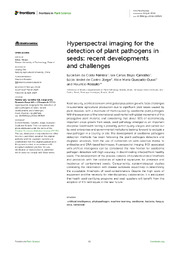Hyperspectral imaging for the detection of plant pathogens in seeds: recent developments and challenges.
Hyperspectral imaging for the detection of plant pathogens in seeds: recent developments and challenges.
Author(s): FERREIRA, L. C.; CARVALHO, I. C. B.; JORGE, L. A. de C.; QUEZADO-DUVAL, A. M.; ROSSATO, M.
Summary: Food security, a critical concern amid global population growth, faces challenges in sustainable agricultural production due to significant yield losses caused by plant diseases, with a multitude of them caused by seedborne plant pathogen. With the expansion of the international seed market with global movement of this propagative plant material, and considering that about 90% of economically important crops grown from seeds, seed pathology emerged as an important discipline. Seed health testing is presently part of quality analysis and carried out by seed enterprises and governmental institutions looking forward to exclude a new pathogen in a country or site. The development of seedborne pathogens detection methods has been following the plant pathogen detection and diagnosis advances, from the use of cultivation on semi-selective media, to antibodies and DNA-based techniques. Hyperspectral imaging (HSI) associated with artificial intelligence can be considered the new frontier for seedborne pathogen detection with high accuracy in discriminating infected from healthy seeds. The development of the process consists of standardization of methods and protocols with the validation of spectral signatures for presence and incidence of contamined seeds. Concurrently, epidemiological studies correlating this information with disease outbreaks would help in determining the acceptable thresholds of seed contamination. Despite the high costs of equipment and the necessity for interdisciplinary collaboration, it is anticipated that health seed certifying programs and seed suppliers will benefit from the adoption of HSI techniques in the near future.
Publication year: 2024
Types of publication: Journal article
Unit: Embrapa Instrumentation
Keywords: Machine learning, Nematode, Phytopathogen, Seedborne
Observation
Some of Embrapa's publications are published as ePub files. To read them, use or download one of the following free software options to your computer or mobile device. Android: Google Play Books; IOS: iBooks; Windows and Linux: Calibre.
Access other publications
Access the Agricultural Research Database (BDPA) to consult Embrapa's full library collection and records.
Visit Embrapa Bookstore to purchase books and other publications sold by Embrapa.

